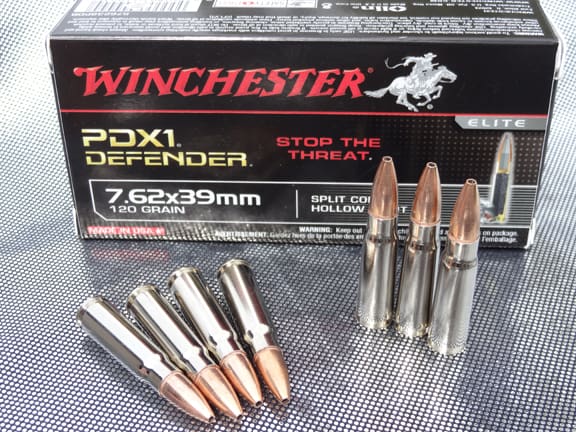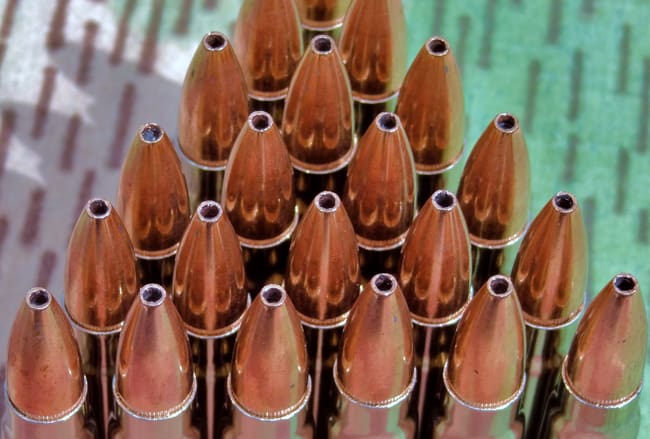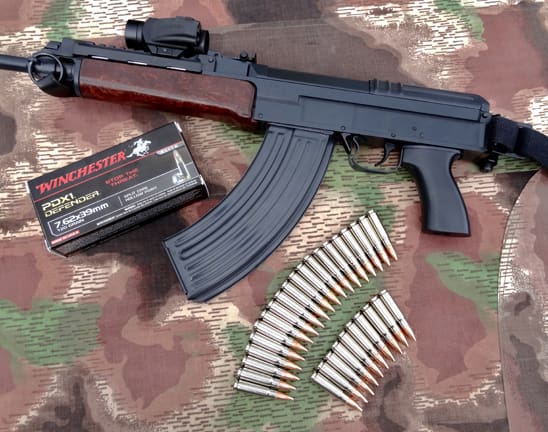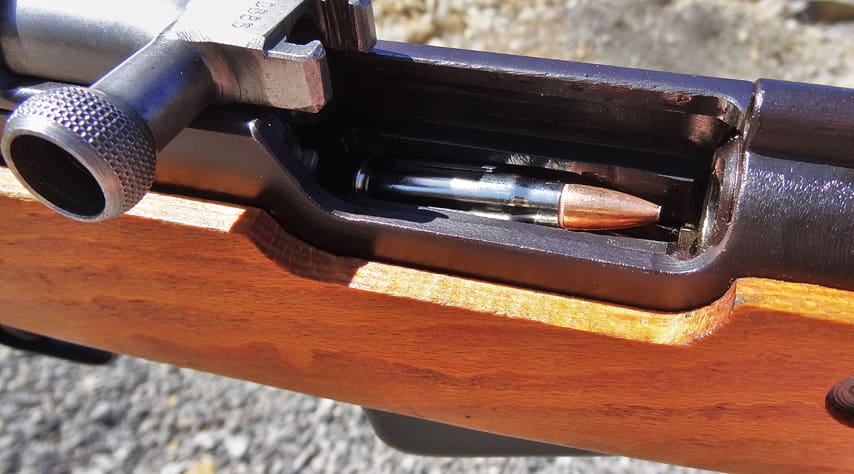Winchester Ammunition has expanded their line of premium self-defense ammunition known as “PDX1 Defender.” The newest caliber: 7.62×39mm. It’s a great addition to the product line, since there’s little widely available premium ammo for this workhorse commie caliber. Hornady’s 123 grain Z-Max is the only direct competition that comes to mind. Although more of a specialty round, Winchester’s new Razorback XT round is also worthy of mention as a premium hunting round. But where the Razorback features a solid, lead-free bullet optimized for thick-skinned ungulates such as Sus scrofa, the PDX1 is designed to expand more rapidly, presumably in bipedal vermin of the homo-sapiens or homo neanderthalensis variety. Don’t laugh – there are definitely some of those Neanderthals still running around – I’ve met a few personally . . .
The new PDX1 bullet uses Winchester’s split-core technology (SCT). SCT is a bullet-making process designed to optimize the bullet’s terminal expansion effects by varying the way the lead core bonds with the outer jacket. The rear 2/3rds (or so) of the lead alloy core is electro chemically bonded to the copper alloy jacket, but the front 1/3 portion is not. The “welded” rear core allows the bullet to retain its structural integrity as it passes through soft tissue and bone, ensuring good penetration. By not bonding the front portion of the core, Winchester’s design allows the bullet to rapidly expand upon impact.
Thus, the PDX1 bullet will mushroom in similar manner to a soft point, but without the attendant reliability or feeding problems associated with using soft points in a semi-auto rifle. The protected hollow point promotes sure feeding and initiates quick expansion.
The PDX1 sports a 120 grain bullet rated at 2365 fps. That equates to 1490 ft-lbs of energy at the muzzle with a ballistic coefficient of .0248. Table 1 reproduces the ballistics table found on the packaging for this new round:
|
Muzzle |
50 yards |
100 yards |
|
| Velocity (f/s) |
2365 |
2199 |
2039 |
| Trajectory (in) |
-1.5 |
0.2 |
0 |
| Energy (ft-lbs) |
1490 |
1288 |
1108 |
Source: Winchester
Field Testing
I fired a total of 100 rounds of the PDX 1 ammunition. I fired 40 rounds for accuracy and chrono results, and another 40 rounds for reliability in a variety of weapons that I knew had a history of running smoothly with FMJ ammo. I used the final twenty rounds to experiment on a variety of media to test expansion and penetration.
First, I placed 10 rounds in the magazines of each of the four rifles and shot them as fast as I could pull the trigger. This testing was done right at twilight so that the low flash powder could be tested as well. The Winchester PDX 1 cycled reliability in all four rifles. There was no noticeable difference in recoil when compared to other commercially available rounds. The low flash powder did result in noticeably less visible flash, esp. out of the Vz 58. Flash was still noticeable out of the 12 inch barreled AMD-65, but it was noticeably less than the fireball created by Wolf, Tulammo, and Yugo Surplus ball.
My chrono testing consisted of two separate shooting sessions wherein 5 rounds were fired from each of four different rifles, for a total of 40 rounds. I recognize that this is a small statistical sample, but my results were consistent so I have fair degree of confidence in the data. My testing revealed the following ballistic results:
| Barrel length (in.) | Av. Muzzle velocity (f/s) | Accuracy (50 yd) (in.) | |
| Yugo 59/66 (SKS) |
22 |
2408 |
1.6 |
| Vector Arms AKMS |
16 |
2280 |
1.4 |
| Czech VZ-58 |
14 |
2268 |
1.1 |
| FEG AMD-65 |
12 |
2200 |
0.9 |
I found that Winchester PDX 1 met or exceeded the advertised 2365 f/s from an SKS design with a 22 inch barrel. Winchester doesn’t say on the packaging how long of a barrel was used to get their 2365 f/s figure, but based on my testing, I suspect that it’s a 20 inch barrel. Velocity naturally dropped with the shorter-barreled rifles.
I found a surprising correlation between the length of the barrels and accuracy: the shorter the barrel, the better accuracy. I’m not willing to draw any scientifically relevant conclusions from my testing concerning barrel length and accuracy, though. Based on prior testing, I’m of the opinion that this particular YUGO 59/66 is inherently less accurate than the other rifles I used in the test despite its “like new” condition. Conversely, my prior testing with the FEG AMD-65 revealed it to be an unusually accurate sample. The other two rifles produced results in an expected range, and any variations between the two is likely attributable to other factors, such as better trigger, better sights, etc.
I can say that, as you’d expect, the Winchester consistently outperformed Russian steel cased ammo, which usually fairs rather poorly in the accuracy department. I didn’t notice any significant difference in accuracy when comparing the Winchester PDX 1 to Winchester White Box, Hornady 123 Grain A-Max (steel case, Zombie box), Federal American Eagle, or Remington UMC. Overall, though, I thought the Winchester PDX was slightly more accurate that the other U.S. manufactured ammo. Admittedly, my statistical sample for comparison was rather small, and shooting non-scoped rifles tended to mask any differences.
I was hoping to do some testing to determine if the PDX1 would have a noticeably different result on soft tissue at short (DGU) ranges, when compared to FMJ ammo. The 7.62 x 39 FMJ round has a reputation for relatively poor performance on soft tissue, making relatively small wound channels while traveling through 30(+) inches of ballistic gelatin. The PDX 1 ammo is intended to solve that problem, by giving the round the ability to mushroom quickly upon impact, thereby transferring more of its energy into the target.
Not having access to ballistic gelatin made that difficult. I had no prior experience testing ammo in this manner, so my perspective is strictly that of a consumer. Also, I had never shot an AK at any living animal so I also didn’t have any experience with the terminal effects of the 7.62 x 39 round. I have been on the receiving end of 7.62 x 39 rounds fired from long range, but fortunately, the bad guys missed.
So lacking ballistic gelatin, I thought it might be fun to experiment on some meat. I had a hard time finding chunks that were both large enough and had bones intact – to simulate a bad guy. I ended up using two 20 lb. hams. I realize that cured meats will probably react differently to bullet impacts than would a bullet hitting living tissue. Nonetheless, I thought that videoing the results of shooting might nonetheless reveal something useful. If nothing else, it’s pretty decent gun porn.
We set up the hams on a table and shot them with the Yugo 55/66 at 15 yards. In both cases, the bullets shredded bone and exited through the meat, making bullet recovery impossible. The video reveals that the PDX 1 reacted much more violently upon impact compared to Wolf 123 grain FMJ.
While certainly not scientific, it’s clear that the PDX1 ammo transferred more energy to the meat, as evidenced by the fact that it blew the pork off the table and made smaller chunks that flew 10-20 feet through the air. The FMJ round, on the hand, split the ham in two but left considerable pieces behind.
The PDX 1 also completely obliterated a 1 gallon jug of water and a 15 inch diameter watermelon. The watermelon was blown into so many pieces that none were bigger than 2 x 3 inches or so. In fact, to my disappointment there was no part of the watermelon left that was even “edible,” as the insides were basically liquefied.
I think more detailed testing is definitely needed to conclusively determine the extent of the difference between PDX1 and FMJ. That being the case, I hope to fly down to Texas sometime soon to reduce the feral hog population with both Winchester PDX1 and Razorback ammo.
Conclusion
After shooting 100 rounds of this pricy ammo ($30 for 20 cartridges), it’s obvious that this is very high quality fodder for your AK, Vz58, or SKS. Whether for hunting, self-defense, or TEOTWAWKI/STHF scenarios, folks seeking to maximize the effectiveness of their eastern bloc gun on soft tissue will likely find no better civilian-legal ammunition than the PDX1.
I must confess that I have some lingering doubts as to the necessity of an expanding rifle bullet for self-defense purposes at close range. For downing a deer or exploding woodchucks? Roger that, there’s none better. And the PDX1 would likely stand much less chance of passing through a human target than a FMJ round, which, in a home defense situation, is definitely a good thing.
But if over-penetration isn’t a concern, it seems that any 7.62 x 39mm ammo (FMJ, SP, etc.) would be plenty lethal at any reasonable self-defense ranges (10 meters or less). While it’s possible to envision some legitimate DGU scenarios where the engagement range might be 100 yards or more, that would be a rare encounter indeed. Viewed in this light, PDX1 might offer a “dead vs. deader” advantage; perhaps akin to the “11” setting on that dude’s amp in Spinal Tap. It does look awfully cool, though.
Specifications:
Bullet Weight: 120 grain
Muzzle Velocity: 2200-2400 f/s, depending on barrel length.
Price: Expect this ammo to retail for somewhere in the neighborhood of $30 a box of 20.
Overall Rating: * * * * *
This is top quality ammunition. PDX 1 will not only turn your AK in a good deer rifle out to 150-200 yards or so, depending on how comfortable you are making a clean kill at those ranges, but will be reliable for use as home defense ammo, should you be so inclined. While I suspect that the any 7.62 x 39 FMJ round will reliably get the job done in a DGU situation, the low flash powder alone makes this ammo the logical choice for night encounters.










At only 1.00 per round its such a bargain to shoot thru a 99 dollar SKS.
Believe it or not, that Yugo SKS variant will fetch upwards of $400-500 these days, and that price is not tacking on the Sandy Hook premium.
I buy Sunoco 104 octane race fuel at 10.50 a gallon for my 98 Geo Metro, because y’know, it gives it more power and stuff.
I have seen Suzuki cars (chevy sprint, geo metro, suzuki swift GT) that need that extra octane to keep knock away. And a geo metro convertible with a tuned suspension that shows up to autocross events, if he shows, the heavy iron boys don’t unload the mustangs and vetts, tired of being beat.
Shut up asshole, seriously.
$99 SKS? Where?
Not where, LGG, but when.
A better time in my life, shoulda jumped on those when they were $200…
I traded some $100 marine binos for an M38 Nagant, which I then traded for a nice early Navy Arms-import Norinco SKS. Does that count?
At last weekend’s gun show in Denver, most of the SKS’s had price tags of around $699.
That means my Spanish FR8 bolt action must be worth 5K now.
I’ve bought a Norinco a month ago on GB for $270. But, admittedly, it was a rather good deal compared to most others that were available there.
Nice video tests… though $30 for a box of 20 is pretty pricey. I’m still interested in trying some if I get my hands on some…
My self-defense choice right now for my Arsenal are some SP rounds by Prvi Partizan… I bought them back when ammo was cheap and plentiful. Oh, happy days gone by…
Green Tip 556 is selling for .90 cents Plus Shipping
Face palm. M855 /SS109 (aka “Green tip” 5.56) has a steel penetrator core and would be the last thing you would want to use for a close range DGU. It will go through 1/2 inch of steel at 100 yards.
Joe Grine
You need to keep the context of the thread clear in your mind
before you commit your thoughts to text.
The thread is ammo costs
As to your face palm moment; do you actually think a X39 HP has a lower penetration factor in a “Self-Defense” situation than GT 556?
The context of the thread is 7.62×39 defensive ammo. The context of your response is the cost of ammo. If you want to just compare cost, you can still find FMJ 7.62×39 for less than $0.50/round. You can even find the excellent GT for around $0.30/round.
Yes, and probably by a factor of 3x or 4x.
M855 yaws and fragments quite nicely in soft tissue, at least from barrels at least 16″ long, out past 50m, out past 100m from a 20″ barrel. It’s only from the 14.5″ barreled M4 carbines that it exhibits inconsistent, usually mediocre performance, due to velocity loss.
Such a bargain! Last December it averaged 30 cents per round, so the same ammo on the floor of the warehouse has tripled in price because Obama is a demagogue!
The suds drinkers better hope Obama doesnt decide beer is a threat to children anytime soon.
My real concern with any American made x39 in my Russian sks is the primers. I’ve heard horror stories of the soft commercial primers making an sks go full auto. The only malfunction I’ve ever had in my sks was with white box winchester ammo. It seemed to be underpowered and would not cycle the action smartly enough to be sure the spent case got clear.
And, as was said above, over a buck a round for my 99 buck rifle seems a little excessive.
>> I’ve heard horror stories of the soft commercial primers making an sks go full auto.
That’s what spring loaded firing pins are for.
int19h. If the Russian ammo dries up completely or some other reason I’m unable to get the steel cased ammo for my sks I’ll send the bolt group off for the spring loaded pin. If I remember correctly there’s a place in Texas that does the work.
Most of my rifle time at the range is with rimfires and my Mosins. My sks is mostly an extreme SHTF precaution.
Well, I’ve always appreciated premium ammo, and this was an excellent review. When it comes to self defense or hunting, I have no problem with expensive ammo. A full review of this ammo in .223 / 5.56 would be great. I know there was a preview awhile ago. I currently have Winchester PDX in my duty .40 and off-duty .40 Glocks.
When it comes to self defense or bunting, premium ammo is the way to go. Provided it works reliably in your given firearm, of course. I took my first deer in 1992 with a .30-30 Marlin 336C that I bought on a private sale for $160. That rifle was fed by 170 grain Nosler Partitions, which were probably around $18 a box, even in 92. I still remember that shot, and I remember that I had confidence in the gun and the ammo before I even pulled the trigger. My dad made the rack of that 8 pointer into custom oak bookends which instill have today.
I love watching water jugs and hams go pop as much as anyone. Really, I do.
But if you want basic cred, spend 3 minutes learning how to make gel. There’s this neat new thing called google…
Gel takes a lot of space in a fridge or freezer to properly cool while making. Not everybody has that luxury.
16V: I agree with your point… Trust me, we debated the logistics of using ballistic gelatin, and it just really is not feasible. If we had access to some land suitable for shooting rifles that also had a spare (i.e. empty) on-site frig, then it would be feasible. You have to keep the temperature just right, so transporting gel to the field is not an option. Certainly, if there is any body in the Portland Metro area that has these two essentials (land/frig) and would like to help out with some testing, then please let know. But without those requisites, we will have to stick to “bubba” testing methods. Sorry.
Joe, as long as you actually do know how to make it, that’s all ya gotta say.
If you don’t feel like making a bunch of 10% jello and schlepping it, I get that. You don’t have an extra $100 for a shop fridge or you don’t have room, I get that too. Perfectly understandable.
You might want to look into the synthetic gels – reusable, no cooking, no refrigeration, meets FBI protocols. Clear Ballistics pops to mind and there’s at least 4 or 5 other players in that market.
Non expanding bullets are much of the reason for soldier complaints about the 5.56mm cartridge. In Vietnam, the lead core bullet was unstable on impact and fragmented after tumbling. The current green tip is more stable, less likely to tumble, and has been known to zip through unarmored targets like a laser beam.
One of our company snipers in Baghdad shot a guy four times with green tip, including two torso hits. He waited until the guard shift on the tower changed, and came to the gate claiming he had been shot by insurgents.
Expanding/frangible rifle bullets are a good thing.
No where in this thread did you see anyone recomend ball ammo for “Self Defense”
The AK next to my bed has a mag full of Yugo brass case FMJ, I live in the sticks where overpenetration thru a car door and into an escaping home invader is desireable.
Depending on where you live, a DA might view that as a prosecutable attack that was made after the threat was gone. YMMV
Yay ammo testing! Would definitely like to see some gel data, though. Otherwise, good stuff.
An 1120-round crate of M67 very recently cost me $425 – That is a bargain when the store shelves are bare and even though a few months back, the same crate cost $300.
I see no reason to buy this stuff if it can hit an 8″ target at 50 yards with the same reliability as the M67 or Tula or Wolf or MFS…..coming out of an AK or VZ.
I would have liked to see this stuff tested in a CZ bolt action rifle in x39 and a Mini30, though….. I think that is where you might see more interesting results.
Ha! I have a NOS Norinco SKS I bought last year for $NZ495 (about $US450). We can still buy them! I pay $NZ14 (about $11) for cheap ammo. On the 5.56: the round was originally intended to tumble and wound, causing enemy troops to be tied up carrying wounded back to the rear (two men carrying per wounded). Wrong on both counts. A: Fanatical suicide troops do not stop for their wounded; B: Little Asian men are strong enough and light enough for one man to carry a wounded man back. This round was designed by someone not intending to be in the field. For the strongest army to carry the weakest round… Don’t even mention 9mm!
$30 for a box of 20? No thanks. Hollow points suck in most AK variants anyway.
I have had problems with Soft Points in AKs and VZ 58s, which is why I dedicated 40 of the 100 rounds to reliability testing. I tried out four of my personally owned guns (shown above) and did not have any failures to feed. Based on that (admittedly limited) experience with this ammo, I feel relatively comfortable concluding that Winchester solved that problem.
yay for content… good review MOAR AMMO TESTING!
I’ve had very good luck with the Hornady plastic tip in 7.62x54R, and would be quite surprised were there not a comparable 39mm round.
I use FMJ at the range only, SP for hunting and self defense for my Norinco SKS. I want expansion. Most FMJ will only place small hole in the front and one in the back; occasionally some tumbling. If you don’t hit a vital organ: a minimal effect. Also, tremendous over penetration(20 +”) in BJ For home SD I use the Hornady SST(Z- Max, what ever they call it). Bought my Norinco SKS in 91 for &79, still in plastic and cosmoline. Great for what it is: out to 150M ; 3inches.
Remember this: these are Hunting rounds meant for deep penatration
Different rifles have different preferences. I have a CAI RPK that loves a certain Russian HP -nickel sized groups at 100yrds, Domestic SP-quarter sized and Russian/Domestic FMJs silver dollar sized(with a winger occasionally from the Russian). Every gun will shoot a little differently and “prefer” a different round over others. That said, I may try some of the PDX just for kicks.
In case you’re interested in a gel results… Posted a video of an informal 10% gel test on this ammo.
https://www.youtube.com/watch?v=lzQ6fdG6rwo
Don’t hate!
I have a theory:
I would suspect that these Winchester rounds have a bullet diameter of .308
The guns you mention shooting this ammo through, typically have a barrel groove diameter of .310 or .311.
This basically means that the bullet will bounce around in the barrel and loose accuracy.
It will also loose “umph”, as more gases are escaping around the bullet as it travels down the barrel, than what should be escaping.
This also would be the reason that the shorter barrel gives you better accuracy, as the bullet does less bouncing prior to leaving the barrel, and gases have less time to escape.
90% or more of 7.62 x 39 ammo available, has a bullet diameter of .310 or .311.
This is a good match for AK’s or SKS’s, but in a gun such as a Ruger Mini30, these rounds will shave the barrel, and produce higher chamber pressures than what the gun is supposed to have.
Ruger, fortunately has compensated for this in the Mini30, by producing a method for the over-pressures to escape, but at the cost of projectile performance.
Other .30 caliber firearms do not compensate for this though, and firing the .310 or .311 sized bullet could be catastrophic if their bore groove diameter is .308.
I strongly recommend that you mic the barrel and bullet of any 7.62, or .30 caliber firearm other than your typical AK’s or SKS’s prior to shooting them, and use the appropriate ammunition for the gun.
Also, once a foreign round is fired through the barrel of a Mini30, firing American ammunition through it (true .308 diameter bullets), will loose accuracy, as they will then likewise bounce around in the barrel and loose gas pressure behind the bullet.
Therefore, if you have a new Ruger Mini30, try this ammo in it and it will probably perform very well.
But if shooting AK’s or variants, SKS’s, or the like, stick with the Russian, or foreign ammo.
Cheap foreign ammo will actually perform better in these weapons.
Aren’t we forgetting this ammo should penetrate less in an urban environment? Sure this or FMJ would do the job, but this PDX-1 stuff should stop sooner, protecting innocent people around your apartment.
Good additional video..
https://www.youtube.com/watch?v=W6KXlbZDCeE
Comments are closed.